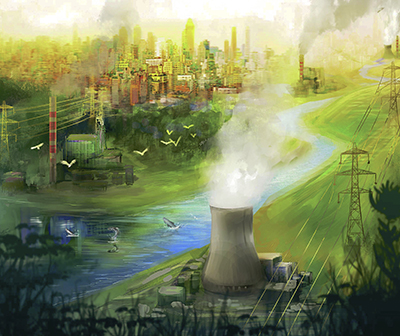
The Northeast Regional Earth System Model
Capstone Products
Riverine ecosystem services and the thermoelectric sector:
Strategic issues facing the Northeast

|
|
Read the journal article Here |
NE-RESM researchers investigated 5 planning scenarios and their impacts on the 384 thermoelectric power plants in the United States:
- The enforcement of Clean Water Act regulations that limit thermal pollution, without no allowance for variance permits.
- Increased electricity demand, with no technology advancements.
- Technology advancements and the adoption of more efficient cooling systems.
- Future climate and hydrologic conditions (based on the SRES A2 Scenario Results).
- A combination of Scenarios 1-4.
The results from this study also show that climate change is a significant cause for concern for the future of the Northeast’s energy system. Climate change may lower power plant efficiencies and these impacts are increased when warmer temperatures are combined with Clean Water Act Thermal river temperature limits, even when accounting for advances in cooling technology and increases in efficient NG based capacity. However, Clean Water Act regulations, paradoxically, have the potential to increase the productivity of some power plants by limiting the thermal pollution of upstream plants. These results signify the importance of optimizing the planning distribution and locations of future power plants in the context of multi-plant impacts.
Environmental conditions should be considered alongside electricity generation planning, as preserving ecosystem services can allow for a more productive regional energy system and improved aquatic habitat. The framework developed in this study will allow regional decision makers to identify strategies and opportunities to achieve both of these goals for the 21st Northeast.
Thermoelectric power plants boil water to create steam that in turn drives turbines to produce electricity. Powered by oil, natural gas, coal or nuclear energy, they provide over 90% of the electricity consumed in the Northeast. Cooling the waste heat generated during the process requires that prodigious volumes of water be withdrawn. This water is then either evaporated in cooling towers or returned to receiving waters at elevated temperatures.
In the Northeast, rivers can help mitigate these added heat loads through the ecosystem services of conveyance, dilution, and attenuation — essentially acting as horizontal cooling towers as water flows downstream. NE-RESM modeling shows that, of the waste heat produced during the production of electricity, roughly half is directed to vertical, evaporative cooling towers while the other half is transferred to rivers. Of the waste heat that is transferred to rivers, nearly all is transported to coastal waters and the ocean.
The reliance on riverine ecosystem services to dispense waste heat alters temperature regimes, which impacts fish habitat and other aquatic ecosystem services. This modeling study showed that roughly 4,700 river miles in the region are potentially impacted by power plants, which may considerably impact the habitat of the region’s fish. However, unlike in other parts of the country, the thermoelectric sector causes minimal impacts to river flow due to the reliance of most plants on ‘once-through’ cooling plants, where heated water is returned and the region’s relatively wet climate. In the face of changing climate and increasing energy demand, “it is essential to assess the capacity and associated environmental trade-offs of heat regulating ecosystem services that support the electricity sector. This type of modeling will allow regional decision makers to better understand the unintended consequences to other ecosystem services as we rely on rivers to support generation of electricity.
Read more about this research Here
Watch the video abstract Here
Read the journal article Here

